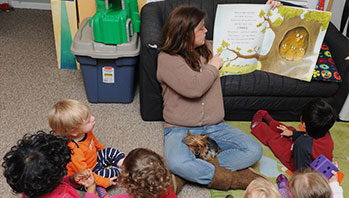- Spicy Hot Colors (book)
- color
MA Standards:
Reading for Informational Texts/RI.P.MA.7: With prompting and support, describe important details from an illustration or photograph.
Head Start Outcomes:
Literacy Knowledge/Book Appreciation and Knowledge: Recognizes how books are read, such as front-to-back and one page at a time, and recognizes basic characteristics, such as title, author, and illustrator.
Literacy Knowledge/Book Appreciation and Knowledge: Asks and answers questions and makes comments about print materials.
PreK Learning Guidelines:
English Language Arts/Reading and Literature 6: Listen to a wide variety of age appropriate literature read aloud.
English Language Arts/Reading and Literature 10: Engage actively in read-aloud activities by asking questions, offering ideas, predicting or retelling important parts of a story or informational book.
Read Together: Is It Red? Is It Yellow? Is It Blue? #1

© Commonwealth of Massachusetts, Department of Early Education and Care (Jennifer Waddell photographer). All rights reserved.
STEM Key Concepts: There are many different colors; A color can have many different shades (from very light to very dark)
ELA Focus Skills: Active Listening, Color Recognition, Parts of a Book, Vocabulary
Hold up the book Is It Red? Is It Yellow? Is It Blue? by Tana Hoban. Read the title. Tell children that this is a book about colors. Point to each dot on the cover and have children call out the name color name.
Then open to the page with the line of colored dots in a vertical column. Explain that on each page there is a photograph with some of these colors.
- Turn the page and point to the red dot at the bottom of the page. Ask, What colors do you see in this photograph? Why do you think the author put a red dot at the bottom of the page with this photograph?
- Emphasize that the dot colors across the bottom of each page are colors that can be found in the photographs on that page.
Before You Read
- Explain that the author uses photographs to show pictures of real things. Make a comparison to the illustrations in Spicy Hot Colors by Sherry Shahan.
- Hold up the cover photograph and ask, What colors do you see in this photograph? What do you think it is a picture of?
- Set a reading focus for children by having them look for the dot colors in the photographs.
As You Read
Encourage children to identify colors in the photographs. Help them understand that the main object in the photograph is the same color as the dots across the bottom.
- Turn to the photograph of the broken umbrella. Point to each dot and have a volunteer point to the corresponding color in the photograph.
- Continue with other photographs.
After You Read
- Review the photographs and colors in the book.
- Ask, What is something you have seen in your neighborhood that is red? yellow? blue?
- Have children point to things in the room or around the school that are red, yellow, blue, etc.
Adaptation: To challenge some children, have them identify objects and discuss shades of color. For example, turn to the page with the striped tents. Say, In the photograph of the tent, there is a white stripe and a red stripe. What happened to the red paint when we were mixing paints and we added white paint to red red paint?
Adaptation: For young children who have trouble concentrating as you move through the book, do just a few pages at a time. Discuss the procedure of matching the dots each time you revisit the book.
English Language Learners: Review color words with children. Create picture cards of recognizable objects. Hold up a card and say: This is a red ball. Have children repeat it after you. Then have them say the color in their home language. Continue the activity until children are able to identify the colors in English on their own. You may want to do only one or two colors at a time until you are sure children have grasped the color and the color word connection.
